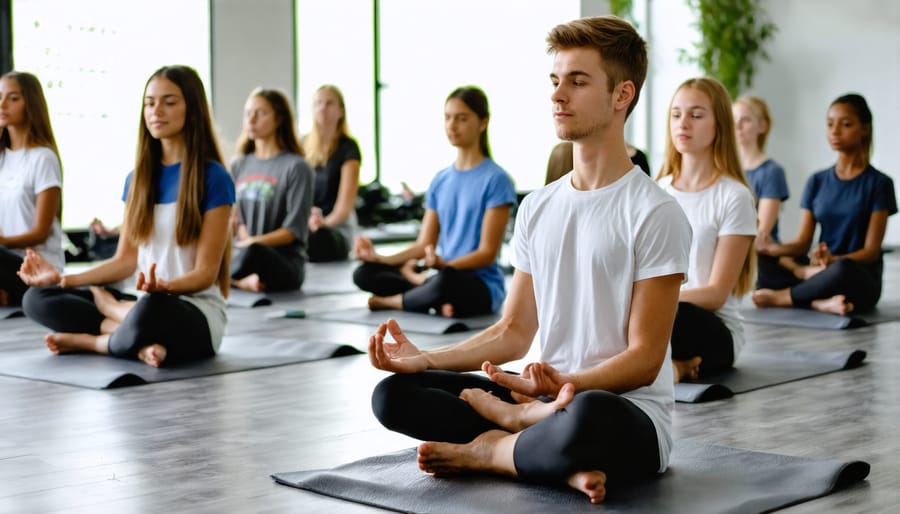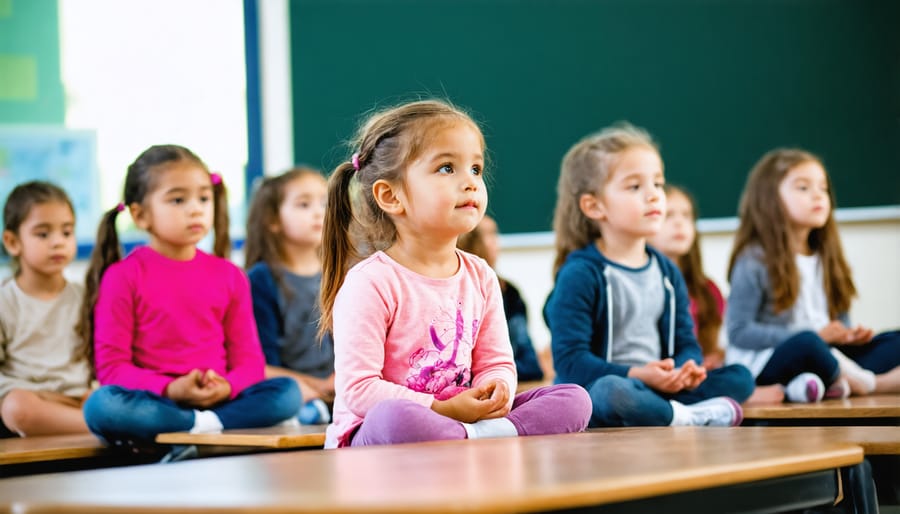Calm Classrooms: Simple Mindfulness Activities That Actually Work
Transform your classroom into a mindfulness sanctuary with quick, accessible practices that seamlessly blend into daily routines. Just like classroom management games, mindfulness exercises create focused, engaged learning environments while reducing student anxiety and improving concentration.
Start with simple 60-second breathing breaks between lessons – students place one hand on their chest, breathe deeply three times, and notice how their body feels. Guide morning arrivals with a gentle “mindful minute” where students close their eyes and listen intently to classroom sounds, grounding themselves for the day ahead. Incorporate movement-based mindfulness through “shake and settle” exercises, where students wiggle out excess energy, then stand perfectly still for ten counts.
These practical techniques require minimal prep time, fit naturally into existing schedules, and create powerful moments of calm that enhance learning readiness. Best of all, they work equally well for both individual students and entire classrooms, making mindfulness an accessible tool for every teacher’s toolkit.
Quick Mindfulness Exercises for Busy Classrooms
Breathing Games
Transform your classroom into a calming space with these engaging breathing games that students love! Start with “Hot Chocolate Breathing” – have students pretend to hold a warm mug, breathe in the chocolatey smell, then cool it down with gentle blows. Perfect for younger learners!
For more active engagement, try “Balloon Belly” where students lie down, place a small stuffed animal on their tummy, and watch it rise and fall as they breathe. Challenge them to keep their “balloon” steady and calm.
“Dragon Fire Breathing” is another crowd favorite – students pretend they’re dragons taking deep breaths in through their nose and breathing out “fire” through their mouth. Make it extra fun by having them hold their hands in front of their mouths to “feel” the warmth!
For quick transitions, use “Five Finger Breathing.” Students trace their hand with their finger, breathing in while moving up each finger and out while moving down. It’s discrete and can be done right at their desks.
Remember to model these exercises yourself and keep instructions simple and playful. These games work best when practiced regularly, even if just for a minute or two.
Mindful Movement Breaks
Movement and mindfulness go hand in hand! Try these simple yet effective exercises to help your students reconnect with their bodies while staying focused. Start with the “Stretching Story,” where students slowly reach up like growing trees or crouch down like tiny seeds while practicing deep breathing. Another favorite is “Animal Walks,” where students move like different creatures (turtle, elephant, or butterfly) while staying aware of their movements and breathing.
For a quick energy shift, introduce “Mindful Dance Freeze.” Play calm music and let students move freely, but when the music stops, they must freeze and notice three things: their pose, their breathing, and one sound in the room. “Mirror Movement” pairs students up to mirror each other’s slow, deliberate movements, promoting focus and body awareness.
Remember to keep these movement breaks short (2-3 minutes) and use them strategically when you notice students getting fidgety or losing focus. These activities work especially well during transitions or after long periods of seated work.
Game-Based Mindfulness Activities

Attention-Building Games
Transform your classroom into an engaging mindfulness space with these attention-building games that naturally boost student engagement while developing focus skills. Start with the “Mindful Bell” game, where students close their eyes and raise their hands when they can no longer hear the bell’s ring – a simple yet effective way to sharpen listening skills and concentration.
Try the “Still Water” exercise, where students sit quietly and imagine they’re a calm lake. Any movement represents ripples, making it a fun challenge to stay perfectly still. This game typically lasts 1-2 minutes and works wonderfully as a transition activity between lessons.
“Attention Spotlight” is another crowd-pleaser where students take turns describing an object in detail for 30 seconds while their classmates listen intently. This not only builds focus but also enhances observation and descriptive skills.
For younger students, “Animal Breathing” combines imagination with mindfulness. Students pretend to be different animals (like a bunny taking quick sniffs or a snake making long hisses), making breathing exercises more playful and memorable.
Remember to start with shorter durations and gradually increase the time as students develop their concentration muscles. Celebrate small wins and make these games regular features in your daily routine for the best results.
Mindful Listening Activities
Let’s explore some engaging listening activities that will help your students develop their mindfulness skills while having fun! The “Sound Safari” is a perfect starter activity – have students sit quietly for one minute and count how many different sounds they can hear. They can write these down or share verbally afterward, creating a collaborative sound map of your classroom environment.
Another crowd-pleaser is the “Mystery Sound Game.” Bring in various objects that make distinct sounds (like bells, paper crumpling, or water pouring) and have students guess what they’re hearing with their eyes closed. This naturally encourages focused attention and builds curiosity.
For a calming transition activity, try the “Mindful Bell” exercise. Ring a bell or chime and ask students to raise their hands when they can no longer hear the sound. This helps them practice deep listening and signals a shift in classroom activities.
The “Sound Journey” is perfect for longer mindfulness sessions. Guide students through imagining they’re walking through different environments (forest, beach, city) while focusing on the typical sounds they might hear. This combines listening skills with imagination and can be adapted for different age groups.
Remember to start with shorter activities and gradually increase duration as students become more comfortable with mindful listening. These exercises can be excellent tools for transitions, morning routines, or when students need to refocus their energy.

Integrating Mindfulness into Daily Routines
Transition Time Techniques
Transitions can be tricky moments in any classroom, but incorporating mindfulness can make these switches smoother and more focused. Just like gaming fundamentals in education, transition techniques work best when they’re engaging and fun!
Try the “Mindful Minute” between activities: Have students close their eyes, take three deep breaths, and quietly focus on the sound of a gentle chime or bell. When the sound fades completely, they can open their eyes, ready for the next task.
Another effective technique is the “Body Scan Express.” Students can stand up, stretch, and mentally check in with their bodies from toes to head in just 30 seconds. This quick reset helps them physically and mentally prepare for the next activity.
Make transitions playful with the “Freeze and Feel” game. Students move freely until you say “freeze,” then they pause and notice three things: what they see, hear, and feel. This brings their attention to the present moment while making the transition fun.
Remember to keep these practices brief and consistent. Your students will quickly learn to appreciate these mindful moments as natural parts of their school day.
Start-of-Class Rituals
Starting each class with a mindfulness ritual can help students transition from hectic hallways to focused learning. Here are some quick and effective routines you can implement:
The “Three Breaths” Welcome: Guide students to take three deep breaths as they settle into their seats. Make it fun by imagining they’re inflating a balloon or blowing out birthday candles.
Mindful Minute: Set a one-minute timer and invite students to close their eyes or focus on a peaceful spot in the room. They can count their breaths or simply observe their thoughts without judgment.
Gratitude Check-in: Ask students to silently name three things they’re thankful for today. This shifts their mindset to positivity before diving into lessons.
Sound Safari: Have students sit quietly for 30 seconds and count how many different sounds they can hear, from distant playground noise to the hum of classroom lights.
Movement Reset: Lead a quick stretch sequence where students reach up high, twist gently side to side, and shake out their arms and legs.
These rituals take just 1-2 minutes but can dramatically improve focus and classroom atmosphere. Choose one that fits your teaching style and stick with it consistently for the best results.

Tips for Success
Start small and be consistent with your mindfulness practice – even five minutes daily is better than longer, irregular sessions. Create a dedicated quiet space in your classroom where students can practice mindfulness exercises without distractions. A cozy corner with cushions or a special “mindfulness mat” can work wonders!
Set clear expectations and establish simple routines. For example, use a gentle chime or bell to signal the start of mindfulness time. This helps students transition smoothly and builds positive associations with the practice.
Make it fun and age-appropriate! For younger students, use playful analogies like “being still as a frog” or “breathing like a sleeping lion.” Older students might appreciate more sophisticated approaches, such as guided visualization or mindful walking exercises.
Track progress using stickers, charts, or digital apps to keep students motivated. Celebrate small wins and improvements in focus, emotional regulation, or classroom behavior.
Remember to model mindfulness yourself. Students learn best when they see their teachers practicing what they teach. Share your own experiences and challenges with mindfulness honestly – it helps normalize the learning process.
Keep sessions brief initially, gradually extending the duration as students build their concentration skills. And most importantly, stay flexible! Some days will be more challenging than others, and that’s perfectly okay.
By incorporating these mindfulness practices into your classroom routine, you’ll create a more focused, calm, and positive learning environment. Remember to start small – even just 2-3 minutes of mindful breathing can make a difference! Customize these activities to fit your students’ needs and grade level, and don’t forget to practice alongside them. The key is consistency and patience. As your students become more familiar with these techniques, you’ll notice improved attention spans, better emotional regulation, and a more supportive classroom community. Make mindfulness a daily habit, and watch as both you and your students reap the benefits of these simple yet powerful practices. Your classroom can become a sanctuary of mindful learning, one breath at a time!


